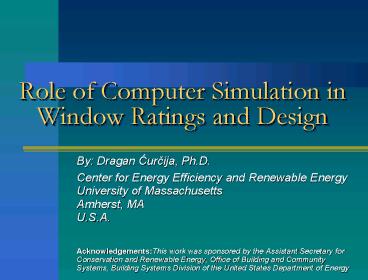Role of Computer Simulation in Window Ratings and Design PowerPoint PPT Presentation
1 / 26
Title: Role of Computer Simulation in Window Ratings and Design
1
Role of Computer Simulation in Window Ratings and
Design
- By Dragan Curcija, Ph.D.
- Center for Energy Efficiency and Renewable Energy
- University of Massachusetts
- Amherst, MA
- U.S.A.
- AcknowledgementsThis work was sponsored by the
Assistant Secretary for Conservation and
Renewable Energy, Office of Building and
Community Systems, Building Systems Division of
the United States Department of Energy
2
BRIEF OVERVIEW
- Evaluation of Thermal performance of windows done
in two ways - Physical testing
- Computer modeling
- In early days (before energy crisis in 70s) only
physical testing - Very limited number of products
- Energy use was not concern, mostly comfort and
liability issues (early failures) - First generation of testing standards
3
OVERVIEW OF TESTING METHOD
- Physical testing expensive and time consuming
- Early testing not very reliable and repeatable
- In North America and European Union Hot Box
method - How is testing used
- in U.S. one specimen per product line. Also all
specimens that dont validate - In Canada testing used for challenge
- In Europe mostly testing used
4
EARLY COMPUTER MODELS
- Research class computer models and general
purpose commercial programs - Better understand energy performance of windows
- Develop algorithms for simplified computer
programs - More detailed than testing results
- Not user friendly
- Too costly for certification purposes
- Early research programs later adopted for
fenestration computer modeling tools
5
RESAERCH CLASS COMPUTER MODELS
6
DEVELOPMENT OF ALGORITHMS
7
PC BASED COMPUTER PROGRAMS
- 20 years ago first computer programs for
fenestration heat transfer - 1-D heat transfer and solar optical properties
for center of glass - 2-D heat transfer in frames and edge of glass
(few years later) - First 2-D programs were FDM based
- Limited functionality
- Inaccurate geometry representation
- Long model preparation time
8
ROLE OF EARLY COMPUTER PROGRAMS
- Reduced cost of evaluating thermal performance
vs. testing - Greater consistency of results
- Complemented testing in design and research
- Changed common wisdom of the role of computer
models - Helped create modern certification bodies
- Accelerated development of stricter code req.
- Helped introduction of performance labels
9
MODERN FENESTRATION COMPUTER MODELING TOOLS
- WINDOW program incorporates GUI, database for
data management - THERM based on FEM (initially developed for
military and space research), user friendly - Allows for accurate geometry representation
- Imports AutoCAD drawings
- OPTICS and RESFEN
- Reduced model preparation time ? decreased cost
of evaluating fenestration products - Program(s) are developed through government
funding and are free for public use
10
WINDOW 5.1
11
THERM 5.1
- Two-Dimensional heat transfer (conduction and
radiation) and Glazing cavity convection
simulation (correlation based)
- First version released in 1994
- Graphic tool to draw the model
- View-factor radiation modeling
- Automatic meshing
12
(No Transcript)
13
MESH REFINEMENT
14
OPTICS 5.1
- Virtual glass laboratory
- Calculate and edit optical properties of glass
and IGU - Change glazing thickness
- Switch glazing coating
- Construct glazing with applied films
- Construct glazing with laminate
15
RESFEN 3.1
- Calculates Residential Energy Impacts
- Annual energy cost impacts of windows
- Uses DOE2.1E calculation engine
- Uses WINDOW output
- Library of standard houses and HVAC sys.
16
COMPUTER TOOLS CERTIFICATION
- Validation studies showed that computer tools can
be reliably used for certification - First started in North America (U.S. Canada) 10
years ago - One validation test (U.S.) and one quality
control test (production line testing) - Validation criteria ?10 (often within 5)
- Limited number of products for which no good
agreement
17
INTERNATIONAL USE OF SIMULATION IN RATINGS
- Computer programs based on best science
- Physics is same everywhere in the world
- Algorithms in WINDOW suite published in North
American international standards (ASHRAE
SPC142P, ISO15099) - Accepted for use in Russia
- Considered for use in Baltic countries, U.K.,
European Union, etc.
18
MAIN PHILOSOPHY
- Complexity is hidden behind ease of use!
- Complex algorithms
- User friendly and convenient users interface
- Premise Accuracy does not have to be sacrificed
in order to create simple elegant computer tools
19
WINDOW5 ENHANCED VISALIZATION
- Virtual Thermograms can provide a full
temperature map of interior surfaces - Areas under condensation can be overlaid to show
critical areas
20
INTEGRATED ENVIRONMENT
21
ADVANCED FEATURES
- Modeling of projecting products Garden Window
22
ADVANCED FEATURES
- Modeling of projecting products Skylights at 20
23
CURRENT AREAS OF PROGRAM DEVELOPMENT
- Condensation Resistance for skylights and
commercial fenestration systems - 3-D Effects
- Specialty Projecting Products
- Improved accuracy in estimating annual energy
performance - Emerging technologies (i.e., Vacuum glazings,
aero-gels,electrochromics, etc.) - Improved accuracy and consistency
24
FUTURE AREAS OF PROGRAM DEVELOPMENT
- 3-D heat transfer models
- Use of CFD for convection heat transfer
- Multi-dimensional solar heat gain effects
- Thermal-structural interaction analysis
- Acoustics analysis
- Durability analysis
- Contact resistance
- Mass transfer (diffusion, infiltration)
25
CONCLUSIONS
- New fenestration computer programs are reliable
tools for estimating thermal performance - Computer modeling should become integral part of
modern ratings procedure - Computer modeling can effectively be used in the
design of energy efficient windows - Further development is necessary to
- improve accuracy for certain class of
fenestration products - Further improve ease of use and simplicity of
users interface
26
THE END For more information http//www.ceere.or
g http//www.nfrc.org http//windows.lbl.gov http
//www.eren.doe.gov

